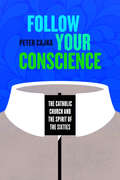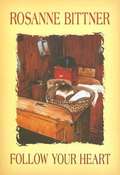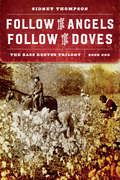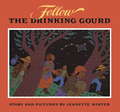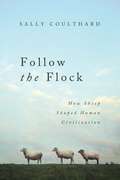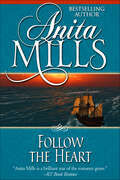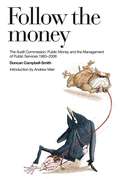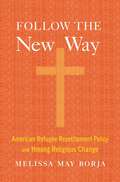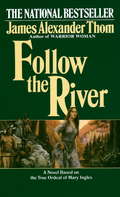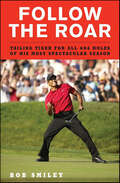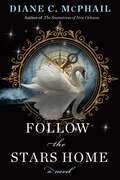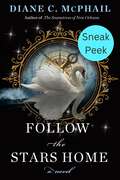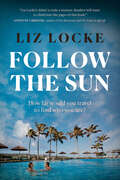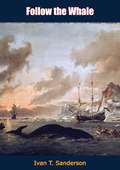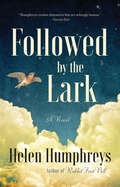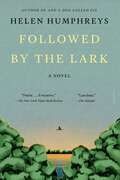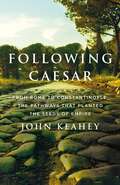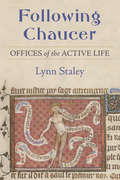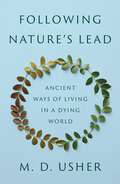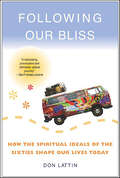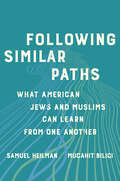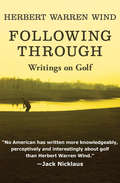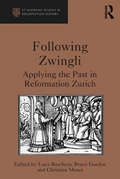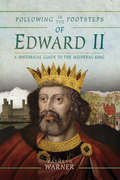- Table View
- List View
Follow Your Conscience: The Catholic Church and the Spirit of the Sixties
by Peter CajkaWhat is your conscience? Is it, as Peter Cajka asks in this provocative book, “A small, still voice? A cricket perched on your shoulder? An angel and devil who compete for your attention?” Going back at least to the thirteenth century, Catholics viewed their personal conscience as a powerful and meaningful guide to align their conduct with worldly laws. But, as Cajka shows in Follow Your Conscience, during the national cultural tumult of the 1960s, the divide between the demands of conscience and the demands of the law, society, and even the church itself grew increasingly perilous. As growing numbers of Catholics started to consider formerly stout institutions to be morally hollow—especially in light of the Vietnam War and the church’s refusal to sanction birth control—they increasingly turned to their own consciences as guides for action and belief. This abandonment of higher authority had radical effects on American society, influencing not only the broader world of Christianity, but also such disparate arenas as government, law, health care, and the very vocabulary of American culture. As this book astutely reveals, today’s debates over political power, religious freedom, gay rights, and more are all deeply infused by the language and concepts outlined by these pioneers of personal conscience.
Follow Your Conscience: The Catholic Church and the Spirit of the Sixties
by Peter CajkaWhat is your conscience? Is it, as Peter Cajka asks in this provocative book, “A small, still voice? A cricket perched on your shoulder? An angel and devil who compete for your attention?” Going back at least to the thirteenth century, Catholics viewed their personal conscience as a powerful and meaningful guide to align their conduct with worldly laws. But, as Cajka shows in Follow Your Conscience, during the national cultural tumult of the 1960s, the divide between the demands of conscience and the demands of the law, society, and even the church itself grew increasingly perilous. As growing numbers of Catholics started to consider formerly stout institutions to be morally hollow—especially in light of the Vietnam War and the church’s refusal to sanction birth control—they increasingly turned to their own consciences as guides for action and belief. This abandonment of higher authority had radical effects on American society, influencing not only the broader world of Christianity, but also such disparate arenas as government, law, health care, and the very vocabulary of American culture. As this book astutely reveals, today’s debates over political power, religious freedom, gay rights, and more are all deeply infused by the language and concepts outlined by these pioneers of personal conscience.
Follow Your Heart
by Rosanne BittnerJude is sent by his father to have farm owners leave their farm and they will lose all they have. Things are complicated when he falls for one of the farmer's daughters. Then secrets from the past come to light, and forgiveness and grace will be needed to find forever love.
Follow the Angels, Follow the Doves: The Bass Reeves Trilogy, Book One (The Bass Reeves Trilogy)
by Sidney ThompsonFollow the Angels, Follow the Doves is an origin story in the true American tradition. Before Bass Reeves could stake his claim as the most successful nineteenth-century American lawman, arresting more outlaws than any other deputy during his thirty-two-year career as a deputy U.S. marshal in some of the most dangerous regions of the Wild West, he was a slave. After a childhood picking cotton, he became an expert marksman under his master&’s tutelage, winning shooting contests throughout the region. His skill had serious implications, however, as the Civil War broke out. Reeves was given to his master&’s mercurial, sadistic, Moby-Dick-quoting son in the hopes that Reeves would keep him safe in battle. The ensuing humiliation, love, heroics, war, mind games, and fear solidified Reeves&’s determination to gain his freedom and drew him one step further on his fated path to an illustrious career.Follow the Angels, Follow the Doves is an important historical work that places Reeves in the pantheon of American heroes and a thrilling historical novel that narrates a great man&’s exploits amid the near-mythic world of the nineteenth-century frontier.
Follow the Drinking Gourd (Dragonfly Books)
by Jeanette WinterIllus. in full color. "Winter's story begins with a peg-leg sailor who aids slaves on their escape on the Underground Railroad. While working for plantation owners, Peg Leg Joe teaches the slaves a song about the drinking gourd (the Big Dipper). A couple, their son, and two others make their escape by following the song's directions. Rich paintings interpret the strong story in a clean, primitive style enhanced by bold colors. The rhythmic compositions have an energetic presence that's compelling. A fine rendering of history in picturebook format."--(starred) Booklist.
Follow the Flock: How Sheep Shaped Human Civilization
by Sally CoulthardAn addictively free-ranging survey of the massive impact that the humble and loveable sheep have had on human history.From the plains of ancient Mesopotamia to the rolling hills of medieval England to the vast sheep farms of modern-day Australia, the domesticated ungulates of the genus Ovis—sheel—have been central to the human story. Starting with our Neolithic ancestors' first forays into sheep-rearing nearly 10,000 years ago, these remarkable animals have fed us, clothed us, changed our diet and languages, helped us to win wars, decorated our homes, and financed the conquest of large swathes of the earth. Enormous fortunes and new, society-changing industries have been made from the fleeces of sheep, and cities shaped by shepherds' markets and meat trading. Sally Coulthard weaves the rich and fascinating story of sheep into a vivid and colorful tapestry, thickly threaded with engaging anecdotes and remarkable ovine facts, whose multiple strands reflect the deep penetration of these woolly animals into every aspect of human society and culture.
Follow the Heart
by Anita MillsLeft destitute after the death of her father, Sarah Spender can barely believe the good fortune that brings the handsome Captain Adam Hastings into her life. When Adam is sent overseas to tame the American Wilderness, even the distance between them cannot tame Sarah's love for him. They are bound together for better, for worse, and forever...
Follow the Money: A History of the Audit Commission
by Duncan Campbell-SmithMost books on politics and government take a view from the top down. They focus on the individuals and institutions that set policies in place and make the laws. But how are these policies and laws translated into action on the ground, where their success or failure helps determine the day to day running of schools and hospitals, police forces and councils? This is the much less familiar territory explored by Follow The Money. It tells the story of the men and women responsible for keeping track of the money spent locally on public services since the early 1980s. What emerges is a rare behind-the-scenes account of the political world in which central government edicts come up against the reality of how things are made to happen at the grass roots. Follow The Money shows how the Commission has helped over 25 years to transform the management of public services, including the NHS, while mediating in an often tense relationship between central and local government from the Thatcher era to the years of New Labour. The result, encompassing a string of scandals and battles between town hall and Whitehall, is a compelling narrative for which an accounting qualification is most certainly not required.
Follow the New Way: American Refugee Resettlement Policy and Hmong Religious Change
by Melissa May BorjaAn incisive look at Hmong religion in the United States, where resettled refugees found creative ways to maintain their traditions, even as Christian organizations deputized by the government were granted an outsized influence on the refugees’ new lives.Every year, members of the Hmong Christian Church of God in Minneapolis gather for a cherished Thanksgiving celebration. But this Thanksgiving takes place in the spring, in remembrance of the turbulent days in May 1975 when thousands of Laotians were evacuated for resettlement in the United States. For many Hmong, passage to America was also a spiritual crossing. As they found novel approaches to living, they also embraced Christianity—called kev cai tshiab, “the new way”—as a means of navigating their complex spiritual landscapes.Melissa May Borja explores how this religious change happened and what it has meant for Hmong culture. American resettlement policies unintentionally deprived Hmong of the resources necessary for their time-honored rituals, in part because these practices, blending animism, ancestor worship, and shamanism, challenged many Christian-centric definitions of religion. At the same time, because the government delegated much of the resettlement work to Christian organizations, refugees developed close and dependent relationships with Christian groups. Ultimately the Hmong embraced Christianity on their own terms, adjusting to American spiritual life while finding opportunities to preserve their customs.Follow the New Way illustrates America’s wavering commitments to pluralism and secularism, offering a much-needed investigation into the public work done by religious institutions with the blessing of the state. But in the creation of a Christian-inflected Hmong American animism we see the resilience of tradition—how it deepens under transformative conditions.
Follow the River: A Novel
by James Alexander ThomMary Ingles was twenty-three, married, and pregnant, when Shawnee Indians invaded her peaceful Virginia settlement, killed the men and women, then took her captive. For months, she lived with them, unbroken, until she escaped, and followed a thousand mile trail to freedom--an extraordinary story of a pioneer woman who risked her life to return to her people.From the Paperback edition.
Follow the Roar: Tailing Tiger for All 604 Holes of His Most Spectacular Season
by Bob SmileyWith his career at a standstill and his golf game a shadow of its former mediocrity, TV writer and ESPN.com contributor Bob Smiley decided the time had come to turn to the one person who might be able to help: Tiger Woods. So, in January of 2008, Smiley set out to follow the game's greatest player from the gallery for every hole of an entire season and to absorb all that he could.Smiley traveled from the seaside cliffs of San Diego to the deserts of Dubai, through the hallowed gates of Augusta National, and on to arguably the greatest U.S. Open of all time back at Torrey Pines, where, in a legendary duel with charismatic journeyman Rocco Mediate, Woods won his fourteenth major—on one leg.Smiley chronicles every dramatic and often hysterical moment of his journey with Tiger, including his off-course run-ins with Arabian sandstorms, ex-con ticket scalpers, and the motley assortment of strangers who became friends along the way.Told from the perspective of a true golf fan, Follow the Roar is a once-in-a-lifetime adventure through the most spectacular and inspiring season in Tiger Woods's celebrated career. In addition to the thrill of witnessing all 604 holes Woods played in '08, Smiley found in Tiger both inspiration and the gutsy embodiment of what it really means to be an athlete—and a man.
Follow the Stars Home
by Diane C. McPhailA captivating reimagining of the intrepid woman who – 8 months pregnant and with a toddler in tow – braved violent earthquakes and treacherous waters on the first steamboat voyage to conquer the Mississippi River and redefine America. The acclaimed author of The Seamstress of New Orleans brings to life Lydia Latrobe Roosevelt&’s defiant journey of 1811 in this lush, evocative biographical novel for fans of Paula McLain, Gill Paul, Allison Pataki, and stories about extraordinary yet little-known female adventurers… It&’s a journey that most deem an insane impossibility. Yet on October 20th, 1811, Lydia Latrobe Roosevelt—daughter of one of the architects of the United States Capitol—fearlessly boards the steamship New Orleans in Pittsburgh. Eight months pregnant and with a toddler in tow, Lydia is fiercely independent despite her youth. She&’s also accustomed to defying convention. Against her father&’s wishes, she married his much older business colleague, inventor Nicholas Roosevelt—builder of the New Orleans—and spent her honeymoon on a primitive flatboat. But the stakes for this trip are infinitely higher. If Nicholas&’s untried steamboat reaches New Orleans, it will serve as a profitable packet ship between that city and Natchez, proving the power of steam as it travels up and down the Mississippi. Success in this venture would revolutionize travel and trade, open the west to expansion, and secure the Roosevelts&’ future. Lydia had used her own architectural training to design the flatboat&’s interior, including a bedroom, sitting area, and fireplace. The steamship, however, dwarfs the canoes and flatboats on the river. And no amount of power or comfort could shield its passengers from risk. Lydia believes herself ready for all the dangers ahead—growing unrest among native people, disease or injury, and the turbulent Falls of the Ohio, a sixty-foot drop long believed impassable in such a large boat. But there are other challenges in store, impossible to predict as Lydia boards that fall day. Challenges which—if survived—will haunt and transform her, as surely as the journey will alter the course of a nation . . .
Follow the Stars Home: Sneak Peek
by Diane C. McPhailBe one of the first to read this sneak preview sample edition!A captivating reimagining of the intrepid woman who—8 months pregnant and with a toddler in tow—braved violent earthquakes and treacherous waters on the first steamboat voyage to conquer the Mississippi River and redefine America. The acclaimed author of The Seamstress of New Orleans brings to life Lydia Latrobe Roosevelt&’s defiant journey of 1811 in this lush, evocative biographical novel for fans of Paula McLain, Gill Paul, Allison Pataki, and stories about extraordinary yet little-known female adventurers…It&’s a journey that most deem an insane impossibility. Yet on October 20th, 1811, Lydia Latrobe Roosevelt—daughter of one of the architects of the United States Capitol—fearlessly boards the steamship New Orleans in Pittsburgh. Eight months pregnant and with a toddler in tow, Lydia is fiercely independent despite her youth. She&’s also accustomed to defying convention. Against her father&’s wishes, she married his much older business colleague, inventor Nicholas Roosevelt—builder of the New Orleans—and spent her honeymoon on a primitive flatboat. But the stakes for this trip are infinitely higher.If Nicholas&’s untried steamboat reaches New Orleans, it will serve as a profitable packet ship between that city and Natchez, proving the power of steam as it travels up and down the Mississippi. Success in this venture would revolutionize travel and trade, open the west to expansion, and secure the Roosevelts&’ future.Lydia had used her own architectural training to design the flatboat&’s interior, including a bedroom, sitting area, and fireplace. The steamship, however, dwarfs the canoes and flatboats on the river. And no amount of power or comfort could shield its passengers from risk. Lydia believes herself ready for all the dangers ahead—growing unrest among native people, disease or injury, and the turbulent Falls of the Ohio, a sixty-foot drop long believed impassable in such a large boat.But there are other challenges in store, impossible to predict as Lydia boards that fall day. Challenges which—if survived—will haunt and transform her, as surely as the journey will alter the course of a nation . . .
Follow the Sun
by Liz LockeFor fans of Jess Walter&’s Beautiful Ruins and Taylor Jenkins Reid&’s Daisy Jones & The Six, Follow The Sun paints a portrait of the 1960s International Jet Set Era through the eyes of an aspiring singer-songwriter, desperate to forge her own path in music and in love. Readers will delight in this sun-drenched trip through a world of fashion, film, and sixties pop culture, written with an emotional, heartbreaking voice reminiscent of Chanel Cleeton.For socialite Caroline Kimball, travel has become an escape—a way to run from her adult responsibilities while hiding her musical ambitions from her disapproving mother. When she meets handsome magazine photographer Jack &“Tex&” Fairchild beside a hotel pool in Acapulco, everything changes. His encouragement shows her she could have a life beyond that of a beautiful, bored heiress, and he convinces her that maybe her childish daydreams aren&’t so impossible after all.Realizing she no longer fits inside her golden cage, Caroline leaves it all behind and runs away with Tex to a small Spanish island, where she finally confronts the tragic death of her father. But when her mother's hidden secrets catch up to her, and a ghost from her past makes a surprising reappearance, Caroline will find herself torn between her whirlwind relationship with Tex, pursuing her music career, or saving her family from financial destitution.Across the stunning beaches of Acapulco and down the powdered ski slopes of Gstaad, Follow the Sun will take readers from the turquoise waters of Formentera to the Sunset Strip, telling a captivating story about following your dreams to discover the person you were always meant to become.
Follow the Whale
by Ivan T. SandersonFrom time immemorial man has pursued the whale. Follow the Whale, which was first published in 1956, tells the story of the people who have engaged in that pursuit—its historical, cultural and economic consequences.In narrative never less thrilling for sticking close to the known facts, biologist Ivan Sanderson has recreated the whole fabulous saga of whaling through the ages—not only from the beginning of recorded history but long before.“The story that follows is an attempt to display this fascinating facet of human endeavor in some semblance of its entirety and in proper perspective by a process of corralling the forgotten and more neglected aspects of whaling history and the new discoveries about the whales themselves, and weaving them into a continuous web of narrative. It is primarily natural history, in both senses of that term. It is the history of man’s conquest of the sea, a saga with a theme so inexorable that it can only be described as natural, and it is a natural history of a group of animals than which there are none more mysterious or romantic in the world. To follow the whale is to follow the whole course of one of the most important and significant aspects of our own history. It is virtually the story of the conquest of our planet.”
Followed by the Lark: A Novel
by Helen HumphreysInspired by his journals and writing, this moving novel inhabits the life and mind of renowned nineteenth-century naturalist, poet and abolitionist Henry David Thoreau, revealing the deep connections between his time and our own. Composed in short, compelling scenes, Followed by the Lark is a novel of significant moments in a life, capturing loss, change and the danger and healing that come from communion with the natural world, set against a backdrop of great change and tumult in America.Renowned nineteenth-century naturalist, poet and abolitionist Henry David Thoreau’s connection to nature was tied to his feelings of loss; before he was twenty-seven years old and went to live at Walden Pond, two of those closest to him had died—his older brother, John, and his friend Charles Wheeler. Nature provided solace for these losses, but the world was changing around him. The forests were being destroyed by the logging industry. Wildlife was increasingly being slaughtered for profit and sport. The railroad clanged through his quiet hometown. And the catastrophes of the American Civil War were beginning to stir. Haunting in its quiet spaces, Followed by the Lark portrays this tension of nature and progress and its effect on a singular man. It is a novel uncommon in its combination of scope and brevity, in its communion with its human subject, and its reflections on an astonishing yet changing world.Thoreau’s life in the early nineteenth century seems firmly in the past, but his time bears some striking similarities to ours. As she explores these intersections in Followed by the Lark, Helen Humphreys elegantly, insistently illustrates how Thoreau’s concerns are still, vitally, our own.
Followed by the Lark: A Novel
by Helen Humphreys“A luscious novel . . . [Helen] Humphreys offers a fresh view of a philosopher thought of as a loner, depicting his family home as a place for communion and companionship . . . This is Thoreau as he really lived.” —Hillary Kelly, The AtlanticA novel as wise as it is tender, a meditation on the miracle of friendship and the heartbreak of change, Followed by the Lark inhabits the life of Henry David Thoreau.Henry felt his pulse quickening with the lengthening days and the return of the birds, with the leafing out of the trees and the whir of the poplars, the trembling song of the frogs in the marsh. We mark time and make our mark on the earth, even as everything around us is shifting and growing, and soon enough these marks will disappear. Friendship comes and reorients us to the horizon; loss comes and stretches out into loneliness. Henry measured and recorded the temperature on and around Walden Pond across the seasons. He built a cabin on its banks and lived there mostly alone—for two years, two months, and two days. He took long walks, floated down rivers with his brother, lost that brother and a friend when they were both still young, read and wrote books, left for the city and came back, heard the romantic whistle of the train transform into the clanging disruption of industry and the destruction of forests hundreds of years grown, watched a young nation rush toward conflict, helped refugees find their next stop on the road to freedom. Inspired by the life, letters, and diaries of Henry David Thoreau, Followed by the Lark shows how strikingly similar the concerns of the early nineteenth century are to our own, and reminds us to listen for news of change: the song of spring’s first bluebird, reports from those who have heard it, and all the sounds and fearful wonders that come after.
Following Caesar: From Rome to Constantinople, the Pathways That Planted the Seeds of Empire
by John KeaheyNATIONAL BESTSELLERA travel narrative following three ancient roads and looking at more than two thousand years of history of Ancient Rome through the modern eye.In 66 b.c., young, ambitious Julius Caesar, seeking recognition and authority, became the curator of the Via Appia, a road stretching from Rome to Brindisi. To gain popularity with Roman citizens along the way, he borrowed significant sums to restore the ancient highway. He eventually achieved greatness in Rome and the far reaches of Gaul, leading armies along the Via Appia and its sister road, the Via Egnatia, across the Balkans, to battle enemies in Roman civil wars.Other armies followed these two roads that eventually connected Rome to Constantinople, today’s Istanbul. Both Octavian and, later, his friend-turned enemy Mark Antony traveled portions of these roads to defeat Caesar’s murderers, Brutus and Cassius. The great Roman statesman Cicero, the Roman poet Homer, the historian Virgil, and many other notables also journeyed on them. In the early second century a.d., the emperor Trajan charted a new, faster, coastal route between Benevento and Brindisi, later called the Via Traiana.Today, the remains of these roads are preserved as archaeological wonders, and can be seen through the countryside near, and sometimes under, modern highways in the ruins of ancient Roman cities. Some of the earliest villages have disappeared, while others have grown into modern towns with the ancient roads hidden beneath latter-day pavements.In this sojourn across Roman history, John Keahey delves into encounters with diverse peoples in these towns in Italy, North Macedonia, Greece, and Turkey, who warmly embrace travelers following in the footsteps of their ancestors. They shared knowledge of historical sites, meals, and a wealth of local lore. Keahey’s unparalleled storytelling breathes life into the prominent figures, pivotal events, and ancient roads that paved the way for the rise and endurance of the Roman empire. It is a journey full of adventure, discovery, and friendship.
Following Chaucer: Offices of the Active Life
by Lynn StaleyFollowing Chaucer: Offices of the Active Life explores three representative figures—the royal woman, the poet, and the merchant—in relation to the concept of “office,” which Cicero linked to the health of the republic, but Chaucer to that of the common good. Not usually conjoined to the term “office,” these three figures, situated in the active life, were not firmly mapped onto the body politic, which was used to figure a relational and ordered social body ruled by the king, the head. These figures are points of entry into a set of questions rooted in Chaucer’s understanding of his cultural and historical past and in his keen appraisal of the social dynamics of his own time that also reverberate in the centuries after Chaucer’s death. Following Chaucer does not trace influence but uses Chaucer’s likely reading, circumstances, and literary and social affiliations as guides to understanding his poetry, within the context of late medieval English culture and the reshaping of the concept of these particular offices that suited the needs of a future whose dynamics he anticipated. His understanding of the importance of the Ciceronian concept of office within the active life, his profound cultural awareness, and his probing of the foundations of social change provide him with a keen sense of the persistent tensions and inconsistencies that are fundamental to his poetry.
Following Nature’s Lead: Ancient Ways of Living in a Dying World
by M. D. UsherIn the spirit of E. F. Schumacher&’s Small Is Beautiful, a dazzling and revelatory exploration of what ancient ideas and ways of living can teach us about creating a more sustainable worldHow should we think and live in a world facing environmental catastrophe? In this urgent, original, and wide-ranging book, classicist and farmer M. D. Usher brings together ancient, indigenous, and modern ideas about how to live in this world and describes how we might begin to reconnect with Nature and heal our damaged planet and lives. The ancients hewed close to Nature, the source of their survival, in ways that most of us can scarcely conceive of today, and ancient philosophy often argues that humans should follow Nature&’s lead. Usher makes the case that Nature&’s resilience can serve as a model for our own responses to climate trauma and all the other harms caused by modern lifestyles.Drawing on philosophy, science, economics, art, literature, history, and religion, Following Nature&’s Lead is both an indictment of human overreach and a celebration of human ingenuity and the adaptability of Nature. Here, Plato meets German biologist Jakob von Uexküll, Lucretius illuminates King Lear, and Diogenes the Cynic crosses swords with Henry Thoreau.Filled with vital and inspiring insights, Following Nature&’s Lead shows how the ancients can help teach us to live in accordance with Nature—and why it&’s essential for human survival that we learn to do so without delay.
Following Our Bliss: How the Spiritual Ideals of the Sixties Shape Our Lives Today
by Don LattinRenowned journalist Don Lattin, longtime reporter for the San Francisco Examiner and more recently the San Francisco Chronicle, interprets the American spiritual and religious landscape since the 60s with insight, wit, and telling reporting. What David Brooks did for the American social and commercial landscape in the bestselling Bobos In Paradise, he does for the spiritual landscape, showing how the 60s have had a profound transformative impact in every area of spirituality. This is the first comprehensive look at the spiritual legacy of the 60s and 70s, as seen through the lives of those raised amid some of the era’s wildest experimentation.
Following Similar Paths: What American Jews and Muslims Can Learn from One Another
by Samuel C. Heilman Mucahit BiliciTwo academics, one Jewish and one Muslim, come together to show how much their faiths have in common—particularly in America. This book provides a braided portrait of two American groups whose strong religious attachments and powerful commitments to ritual observance are not always easy to adapt to American culture. Orthodox Jews and observant Muslims share many similarities in their efforts to be at home in America while holding on to their practices and beliefs. As Samuel Heilman and Mucahit Bilici reveal, they follow similar paths in their American experience. Heilman and Bilici immerse readers in three layers of discussion for each religious group: historical evolution, sociological transformation, and a comparative understanding of certain parallel beliefs and practices, each of which is used as a window onto the lived reality of these communities. Written by two sociologists, one a religiously observant American Jew and the other an American Muslim, Following Similar Paths offers lively insider and outsider perspectives that deepen our understanding of American diversity and what it means to be religious in a modern society.
Following Through: Writings on Golf
by Herbert Warren WindThese essays by the legendary sports writer &“put readers right in the galleries&” watching &“all the great golfers, from Harry Vardon to Jack Nicklaus&” (The New York Times Book Review). In this classic anthology, Herbert Warren Wind recreates Ben Hogan&’s stirring performance in the third round of the 1967 Masters, when the fifty-four-year-old former champion turned back the clock to birdie six of the final nine holes and send spectators home &“as exhilarated as schoolboys.&” At the 1964 US Open, the dean of American golf writers captures the drama and excitement of &“one of the most inspiring stories in American golf&”: Ken Venturi&’s heroic victory over Arnold Palmer, Tommy Jacobs, and a case of heat exhaustion to win his only major championship. From Harry Vardon to Steve Ballesteros, Pebble Beach to Ballybunion, the British Open to the President&’s Putter, this generous and entertaining volume contains Herbert Warren Wind&’s most famous essays on the sport he loved above all others. Vivid, eloquent, and insightful, Following Through showcases a master craftsman at the very top of his form.
Following Zwingli: Applying the Past in Reformation Zurich (St Andrews Studies In Reformation History Ser.)
by Bruce Gordon Luca BascheraFollowing Zwingli explores history, scholarship, and memory in Reformation Zurich. The humanist culture of this city was shaped by a remarkable sodality of scholars, many of whom had been associated with Erasmus. In creating a new Christian order, Zwingli and his colleagues sought biblical, historical, literary, and political models to shape and defend their radical reforms. After Zwingli’s sudden death, the next generation was committed to the institutional and intellectual establishment of the Reformation through ongoing dialogue with the past. The essays of this volume examine the immediacy of antiquity, early Christianity, and the Middle Ages for the Zurich reformers. Their reading and appropriation of history was no mere rhetorical exercise or polemical defence. The Bible, theology, church institutions, pedagogy, and humanist scholarship were the lifeblood of the Reformation. But their appropriation depended on the interplay of past ideals with the pressing demands of a sixteenth-century reform movement troubled by internal dissention and constantly under attack. This book focuses on Zwingli’s successors and on their interpretations of the recent and distant past: the choices they made, and why. How those pasts spoke to the present and how they were heard tell us a great deal not only about the distinctive nature of Zurich and Zwinglianism, but also about locality, history, and religious change in the European Reformation.
Following in the Footsteps of Edward II: A Historical Guide to the Medieval King (Following In The Footsteps Ser.)
by Kathryn Warner&“Informed and informative . . . a meticulous example of outstanding scholarship, and an inherently fascinating read.&” —Midwest Book Review Edward II is famously one of England&’s most unsuccessful kings, as utterly different from his warlike father Edward I as any man possibly could be, and the first English king to suffer the fate of deposition. Highly unconventional, even eccentric, he was an intriguing personality, and his reign of nineteen and a half years, from 1307 to 1327, was a turbulent period of endless conflict and the king&’s infatuation with his male favorites, which ended when his own queen led an invasion of his kingdom. Following in the Footsteps of Edward II presents a new take on this most unconventional and puzzling of kings, from the magnificent Caernarfon Castle where he was born in 1284 shortly after his father conquered North Wales, to his favorite residences at King&’s Langley in Hertfordshire and Westminster, to the castle of Berkeley in Gloucestershire where he supposedly met his brutal death in September 1327, to Gloucester Cathedral, where his tomb and alabaster effigy still exist and are among the greatest glories surviving from medieval England.
